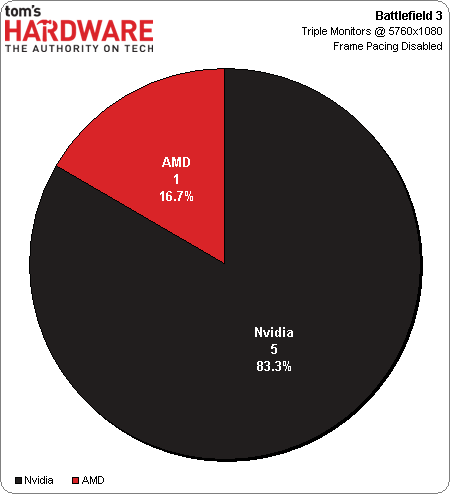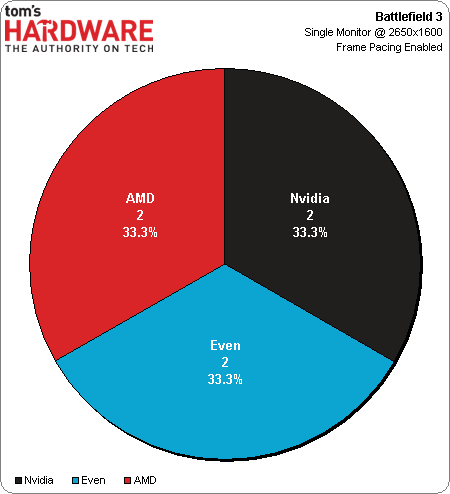Radeon HD 7990 Vs. GeForce GTX 690: The Crowd Picks A Winner
Tom's Hardware enlists the help of /r/Bakersfield, plus some of its Facebook community, to test AMD's Radeon HD 7990 with the latest Catalyst 13.8 beta driver against GeForce GTX 690. The all-day event turned up some interesting observations.
Results: Battlefield 3
Originally, we weren’t going to use Battlefield 3. It’s on the older side, Battlefield 4 is coming soon, and the in-game sequence we use for benchmarking isn’t particularly interactive. Instead, we planned on testing with Tomb Raider. Unfortunately, Tomb Raider’s in-game save system makes it difficult to play through the same sequence without overwriting auto-saves. Very quickly, we ran out of save spots and realized that falling back to Battlefield 3 was necessary.
With each card hooked up to three monitors, the outcome is almost unanimous. Lacking frame pacing, Nvidia wins five votes to one.
The next set of results comes from six different gamers (giving us 12 unique opinions throughout the day). Attached to one 30” screen at 2560x1600, two participants voted for AMD, two showed favor to Nvidia, and two said the experiences were similar enough to call a tie.
Naturally, it would have been great to have even more opinions, to have the same large group judging the AMD-based platform before and after frame pacing, and to more granularly qualify the background of each respondent to better gauge the audience’s threshold for detecting smooth gameplay. However, doing so would clearly require a longer-term study than one full-day event.
This corresponds really well with what Don found in his story, where Catalyst 13.8 beta makes a big difference to the benchmark numbers in Battlefield.
Get Tom's Hardware's best news and in-depth reviews, straight to your inbox.
Current page: Results: Battlefield 3
Prev Page Getting Enthusiasts Together For A Day Of Benchmarking Next Page Results: BioShock Infinite-
iam2thecrowe can you please show cpu useage before and after the driver update, and also show results on a lower end system, like an fx6300 with dual 7850's? That would be interesting.Reply -
bin1127 A great article with some very interesting results.Reply
Chris really knows use funny and imaginative metaphors to start of his articles. Keep up the good work! -
iam2thecrowe can you please show cpu useage before and after the driver update, and also show results on a lower end system, like an fx6300 with dual 7850's? That would be interesting.Reply -
merikafyeah If I had $700 to spend on graphics, I'd buy the fastest single-gpu card there is:Reply
The Galaxy GeForce GTX 780 HOF Edition
http://www.hardocp.com/article/2013/08/14/galaxy_geforce_gtx_780_hof_edition_review/
http://www.amazon.com/dp/B00DZIFN4M/
Out of the box it beats the Titan in pretty much everything and when overclocked I'd bet performance would be indistinguishable from a GTX 690. And did I mention single GPU? Frame-pacing = non-issue. And those temps/noise ratios are in a league of their own. -
iam2thecrowe Reply11482712 said:If I had $700 to spend on graphics, I'd buy the fastest single-gpu card there is:
The Galaxy GeForce GTX 780 HOF Edition
http://www.hardocp.com/article/2013/08/14/galaxy_geforce_gtx_780_hof_edition_review/
http://www.amazon.com/dp/B00DZIFN4M/
Out of the box it beats the Titan in pretty much everything and when overclocked I'd bet performance would be indistinguishable from a GTX 690. And did I mention single GPU? Frame-pacing = non-issue. And those temps/noise ratios are in a league of their own.
you are pretty much right on there. people often overlook galaxy cards (i know i do), for obvious reasons (quality/after sales support) . but this card is insane, with extremely good OC capabilities. If i had a choice between this and a 690, i would certainly take this card. Althogh i would take 2 x of the cheapest 770's available before any of the mentioned cards. -
AndrewJacksonZA I think the most important part of this article is this little gem:Reply
"My wife is in the background with our then-two-week-old baby girl"
Congratulations Chris!!! :-) -
geok1ng With due respect for TH efforts on the subject, but keeping Metro LL results is a BIAS. How about some piecharts WITHOUT METRO LL?Reply -
Bill Reinhardt You know how wine is matched for optimal flavor compatability with certain foods?Reply
http://en.wikipedia.org/wiki/Wine_and_food_matching
You should have done that with beer and video games. -
Iron_Sean Why did you only test Triple monitors with no frame pacing versus single high res monitor with frame pacing?Reply
You're confounding variables and making your results hard to compare directly: Is the difference 6 MP vs 4 MP, frame pacing, or their crossfire/surround technology? This is an interesting idea, but I'd really like to see it narrowed to a single variable to better compare the technologies.


